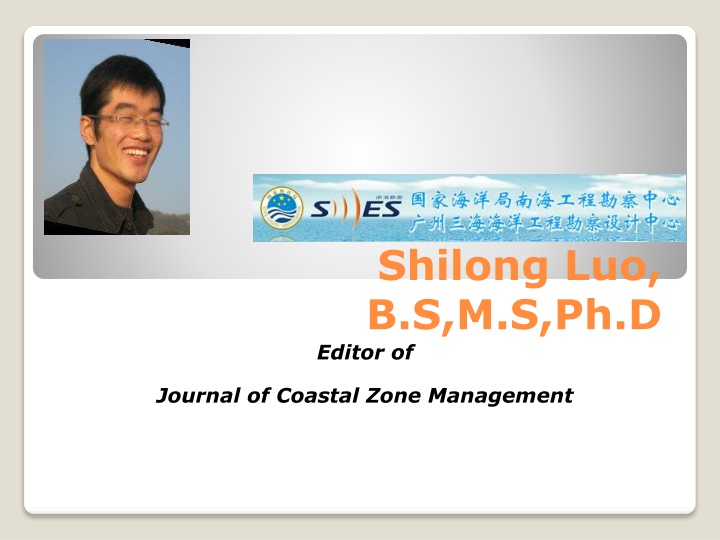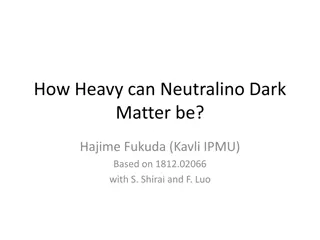
Coastal Zone Management and Beach Nourishment by Dr. Shilong Luo
Dr. Shilong Luo, an editor of the Journal of Coastal Zone Management, is a Ph.D. holder skilled in coastal erosion, protection, and marine engineering surveying. His research interests include beach nourishment as part of coastal defense strategies. He emphasizes the importance of understanding the dynamics of submerged sand in beach nourishment projects. Coastal erosion and management in China are key areas of focus in his recent publications.
Download Presentation

Please find below an Image/Link to download the presentation.
The content on the website is provided AS IS for your information and personal use only. It may not be sold, licensed, or shared on other websites without obtaining consent from the author. If you encounter any issues during the download, it is possible that the publisher has removed the file from their server.
You are allowed to download the files provided on this website for personal or commercial use, subject to the condition that they are used lawfully. All files are the property of their respective owners.
The content on the website is provided AS IS for your information and personal use only. It may not be sold, licensed, or shared on other websites without obtaining consent from the author.
E N D
Presentation Transcript
Shilong Luo, B.S,M.S,Ph.D Editor of Journal of Coastal Zone Management
Dr. Shilong Luo completed his B.S. in Environmental Science from Jimei University, Xiamen, China in 2008. He received his M.S. in Marine Geology from Xiamen University, Xiamen, China, 2011, and he completed his Ph.D. in Marine Geology, Ocean University of China, Qingdao, China in 2014. Current Affiliation: South China Sea Marine Engineering Surveying, SOA, Guangzhou 510300, China. Biography
Beach nourishment, Coastal erosion and protection, Coastal engineering and management, Marine Engineering Surving. Research Interests
Coastal Erosion and Management in the People s Republic of China. Recent Publications
Beach nourishment is typically part of a larger coastal defense scheme. Nourishment is typically a repetitive process, since it does not remove the physical forces that cause erosion, but simply mitigates their effects. Introduction
Seawall Seawall Nourishment Nourishment Vegetation planting Vegetation planting Setback lines Setback lines Coastal management in Fujian, Guangdong, China.
Nourishment is one of three commonly accepted methods for protecting shorelines. The structural alternative involves constructing a seawall, revetment, groin or breakwater. Beaches can erode both naturally and due to impact of humans. Erosion is a natural response to storm activity. During storms, sand from the visible beach submerges to form storm bars that protect the beach. Submersion is only part of the cycle. During calm weather smaller waves return sand from the storm bar to the visible beach surface in a process called accretion. The term erosion conjures visions of environmental damage so the term submersion often replaces it in describing a healthy sandy beach.
The distinction between total sand in a beach and the proportion of the sand above the waterline (submersion fraction) critically impacts beach nourishment. Two beaches with the same amount of visible sand may look much different under water. An eroded beach with substantial submerged sand surrounding it may recover without nourishment. Nourishing a beach that has little submerged sand requires addressing the reason that the submerged sand is missing. Professional Prospects
Beach nourishment has significant impacts on local ecosystems. Nourishment may cause direct mortality to sessile organisms in the target area by burying them in the new sand. Seafloor habitat in both source and target areas are disrupted, e.g., when sand is deposited on coral reefs or when deposited sand hardens. Imported sand may differ in character (chemical makeup, grain size, non- native species) from that of the target environment. Reduced light availability, affecting nearby reefs and submerged aquatic vegetation. Imported sand may contain material toxic to local species. Removing material from near-shore environments may destabilize the shoreline, in part by steepening its submerged slope. Related attempts to reduce future erosion may provide a false sense of security that increases development pressure. Issues that our Profession will face
Definition Beach nourishment is the supply of sand to the shore to increase the recreational value and/or to secure the beach against shore erosion by feeding sand on the beach. This is the common definition for Beach nourishment, other definitions can be discussed in the article.
Beaches can erode both naturally and due to impact of humans. Erosion is a natural response to storm activity. During storms, sand from the visible beach submerges to form storm bars that protect the beach. Submersion is only part of the cycle. During calm weather smaller waves return sand from the storm bar to the visible beach surface in a process called accretion. The term erosion conjures visions of environmental damage so the term submersion often replaces it in describing a healthy sandy beach. Some beaches do not have enough sand available to coastal processes to respond naturally to storms. When there is not enough sand left available on a beach, then there is no recovery of the beach following storms.
Sediment texture (grain size and sorting) is critical for success. Sand fill must be compatible with native beach sand. In some cases, beaches have been nourished using a finer sand than the original. Thermoluminescence monitoring reveals that storms can erode such beaches far more quickly than the natural beach. This was observed at the Waikiki nourishment project in Hawaii. Requirements for Effective Nourishment
Approved By E-signature: Shilong Luo

